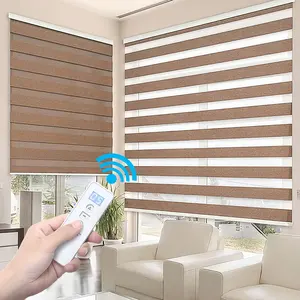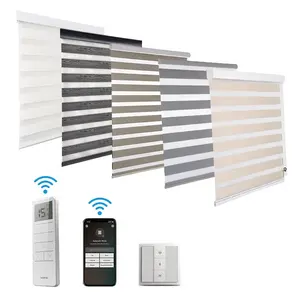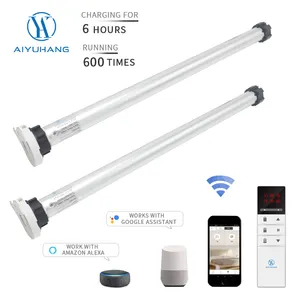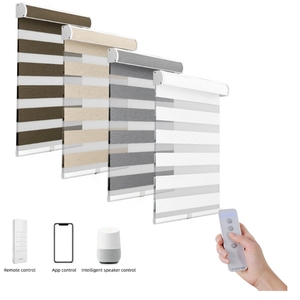(99191 products available)




































































































































































































































A window shade is a window treatment made of fabric, vinyl, or wood. It is pulled down over a window to block light and provide privacy. There are many types of window shades. Each of them has special features. Some of the more common ones include:
Roller window shades:
These are perhaps the simplest yet most popular types of window shades. They have a sleek and minimalist design. Roller shades consist of a single piece of fabric rolled onto a shaft at the top of the window. To use them, pull them down by hand to cover the window. They come in various colors, fabrics, and patterns. Some styles block out all light. Others allow some light into the room. Roller window shades are easy to clean. They are also quite affordable, making them a good choice for almost any room.
Roman window shades:
Like roller shades, roman window shades also fold up when pulled up. They, however, are made of fabric and add a more classic and elegant touch to a room. When lowered, they form soft horizontal folds. They come in different styles, such as flat, looped, and balloon. Roman window shades are available in various fabrics, from sheer to blackout options. They add some decor to the window area. They also regulate the amount of light coming into the room.
Cellular window shades:
These are also known as honeycomb window shades. They are designed to improve energy efficiency. Cellular window shades have a unique honeycomb structure with multiple layers. This structure traps air inside the cells. It helps keep the room warm in winter and cool in summer. The shades are available in different cell sizes and layers. They can be sheer or blackout. They also come in many colors and fabrics to match with almost any decor theme.
Venetian window shades:
Venetian window shades are classic window blinds that have horizontal slats. They are made from wood, metal, or plastic. They can be adjusted to allow in as much or as little light as needed. They are easy to clean and maintain. They are suitable for almost any room, including the kitchen and bathroom.
Wooden window shades:
As the name suggests, wooden window shades are made from wood. They bring a warm and natural feel to the decor. They are durable and suitable for almost all rooms in the house.
Vertical window shades:
These shades have vertical slats or vanes. They can be adjusted to control the amount of light coming into the room. They are ideal for large windows and sliding doors.
Window shades are designed to cover windows and improve home decor. They come in various sizes, colors, and designs to match different home themes. The design aspect of window shades focuses on style and structural elements that make them functional and attractive.
Structural elements
The main part of a window shade is the fabric. It is usually stiffened or woven to create different styles, such as Roman or roller shades. The structural elements include the bottom bar that gives shape and support, the brackets that hold the shade in place, and the cords or mechanisms that allow the shade to move up or down. These elements work together to make the window shade functional.
Styles and designs
There are many styles of window shades to choose from. Roman shades are popular because they fold up neatly and come in different fabrics. Roller shades have a modern look and can be plain or patterned. Cellular shades are great for insulation in winter and summer. Natural shades use materials like bamboo for a rustic feel. Each style has unique folds, patterns, and textures to fit any room's look.
Color options
Color is an important part of window shade design. Window shades come in many colors, from bright primary shades to soft pastels and neutral tones. These color choices help window shades fit in with home decor or make a bold statement. The right color can add style and blend or contrast with the walls and furniture.
Customization options
Many companies allow people to customize their window shades. This means they can choose the exact fabric, color, and pattern they want. Some people even add their designs to make their shades unique. Custom shades are great for matching a room's theme or for special-shaped windows that standard shades can't fit.
Residential Homes:
Window shades can be used in residential homes to improve privacy and security, control the amount of natural light that comes in, and help regulate indoor temperatures. They are also effective in decorating and adding a personal touch to the living space.
Commercial Office Spaces:
In office spaces, window shades are useful for reducing glare on computer screens, providing visual privacy for meetings and workspaces, and creating a professional look. They can also help in energy savings by reducing the load on air conditioning systems.
Hospitality Industry (Hotels, Restaurants, etc.):
Hotels and restaurants can use window shades to create a comfortable and private environment for their guests. Shades can be used to create different moods and themes in dining areas and guest rooms.
Educational Institutions:
Schools and universities can use window shades in classrooms and lecture halls to reduce glare on screens and boards. Shades are also useful in creating a more conducive learning environment.
Healthcare Facilities:
Hospitals and clinics can use window shades to improve patient privacy and control natural lighting in different areas. Shades are important for creating a calm and healing environment.
Retail Stores:
In retail, window shades can be used to highlight merchandise, control natural lighting, and create visual displays. Shades can also be used to create a sense of privacy in fitting rooms.
Government Buildings:
Window shades are important in government buildings for privacy, security, and controlling natural light. Shades are useful in maintaining a professional and functional atmosphere.
Residential Remodeling and Interior Design Projects:
Window shades are often considered as part of residential remodeling and interior design projects. Homeowners and designers can choose shades that complement the overall design scheme and meet the functional needs of different spaces.
When choosing window shades for a home or commercial space, there are many things to consider. These include the type of shade, fabric, color, and size. One must also consider how much light they want to let in and what kind of ambiance they wish to create. Start by assessing the needs and preferences. Consider the functionality, aesthetics, and ease of maintenance. Decide whether one prefers the classic elegance of pleated window shades, the trendy look of bamboo shades, or the versatility of roller shades. Determine if one desires features like blackout capabilities, motorization, or energy-efficient designs.
Next, consider the style and decor of the space. Choose window shades that complement the existing interior design theme. Select colors and patterns that blend well with the walls and furnishings. If the room has a lot of natural light, one should consider window shades that provide UV protection while still allowing some sunlight in. Take measurements of the windows. Decide if one wants inside-mount or outside-mount shades. Inside-mount shades fit within the window frame, providing a clean and streamlined look. Outside-mount shades attach to the wall above the window, making the window appear larger.
Also, think about the material and texture of the window shades. Fabric window shades are available in many materials, such as vinyl, polyester, wood, and bamboo. Each material has unique advantages, such as durability, ease of cleaning, and environmental friendliness. Window shade accessories like decorative trim, valances, and tassels can add a personal touch and make the shades look more elegant. Explore the options for installing and operating window shades. The manual pull cord system is simple and easy to use. Modern motorized window shades offer convenience, especially for hard-to-reach windows or for those who want to create a smart home environment.
Q1: What are the market trends for window shades?
A1: Window shades with smart technology are trending. Consumers want shades that can align with home automation systems. Shades with voice-activated features are also becoming popular. Sustainable window shades are also trending. Shades made with eco-friendly materials like bamboo have more than one function. They are good for the earth and very popular with consumers. Another trend is the demand for easy-to-clean window shades. Shades with vinyl or polyester fabrics are gaining traction. These materials resist stains and are easy to wipe. Shades with geometric patterns are also becoming popular. Bold lines and shapes look modern. Shades with abstract designs add personality. Window shades in jewel tones are also trending. Rich colors like emerald green and deep purple can make a room feel luxurious. The market for neutral window shades is still strong. Shades in gray, beige, and white are versatile and timeless.
Q2: What are the benefits of motorized window shades?
A2: Motorized window shades offer convenience. With the push of a button, users can raise or lower the shades. This is especially helpful for hard-to-reach windows. Motorized shades also provide a clean look. There are no cords or chains to interrupt the smooth lines of the shade. Another benefit is the ability to control natural light easily. Users can adjust the light level with precision. Motorized shades are also compatible with smart home systems. They can be programmed to open and close at specific times. This can save energy and enhance privacy.
Q3: How can window shades be used to promote sustainability?
A3: Window shades can help reduce energy use. They provide insulation and reduce heating and cooling costs. Shades with a high solar heat gain coefficient (SHGC) can keep the room cool by blocking the sun's heat. Shades made with recycled materials also promote sustainability. Look for shades that have certifications. These certifications show the shades meet environmental standards.
The keyword "window shade" has shown a consistent web search volume trend over the past year with an average monthly web search volume of 90,500. Despite a zero percent change in the past three months, there has been a notable 22 percent increase in web search volume over the past year. The detailed monthly data reveal fluctuations, with web search volumes dipping to 60,500 in January 2024 before stabilizing back to the annual average of 90,500 from February onwards.
This keyword experienced its lowest web search volume in January 2024, with 60,500 web searches, which suggests a temporary decline possibly influenced by seasonal factors such as reduced home renovation activities post-holiday season. However, the web search volume quickly rebounded to its annual average by February, maintaining stability through to October 2024. This pattern indicates a strong seasonal influence, with peaks and valleys that align with typical consumer behavior in home improvement and decoration cycles.
The trend analysis for "window shade" highlights a steady interest in home decor solutions, with spikes likely tied to specific times of the year when homeowners focus on interior enhancements. The consistent recovery of web search volume each February suggests a predictable cycle that businesses in the home garden category can leverage for marketing and stock planning. The data underscores the importance of timing and seasonal marketing strategies to capitalize on periods of heightened consumer interest.